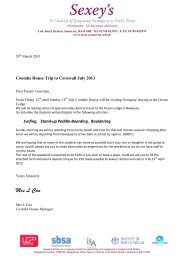Untitled - Sexey's School Moodle
Untitled - Sexey's School Moodle
Untitled - Sexey's School Moodle
You also want an ePaper? Increase the reach of your titles
YUMPU automatically turns print PDFs into web optimized ePapers that Google loves.
“interrogators,” those who subvert the rules of art by violating them. He believes that in<br />
conjunction, they “entail, in the artist’s self-understanding, a trumping of one rule with a<br />
notionally higher rule or ‘law,’ thereby justifying the disregard for the rule by reference<br />
to its inferiority to the other rule or law” (106-7). In sum, a work of art that transgresses<br />
art’s established practices, whether by exploration or violation, innovation or<br />
interrogation of perceived boundaries, serves to promote fresh, i.e. “new” styles, genres,<br />
and techniques, and to contribute to the dynamic evolution of artistic expression. In<br />
twentieth-century literature, a particularly good case in point is James Joyce’s Ulysses.<br />
Joyce’s effective use of the innovative stream-of-consciousness technique not only paved<br />
the way for ensuing generations of writers as mentioned in the first chapter, but it also<br />
contributed to the definition of what would later be categorized as the postmodern novel.<br />
Beyond the canon-augmenting potential of certain works, there is an accepted<br />
view shared by many literary critics that literature has the power to subvert established<br />
hierarchies not only in the canonical discourses of academia but also in socio-political<br />
discourses. For example, Paul Lauter argues that “it would not be too much to say that<br />
canonical criticism constitutes a part of a broader effort to reconstruct our society” (144-<br />
5). Another common conception is that certain literary texts have promoted social and<br />
political changes by influencing public opinion during specific periods in history:<br />
In the 1960s and 1970s, the movements for social change<br />
challenged artists to discover how they might themselves be agents<br />
of change rather than, at best, choniclers of it. Writers have<br />
addressed that challenge in many ways: Alice Walker’s Meridian,<br />
Leslie Marmon Silko’s Ceremony, Adrienne Rich’s The Dream of<br />
a Common Language are among other things, quite different<br />
approaches to the problem of creating texts that are actors for<br />
change. (Lauter 61)<br />
83



